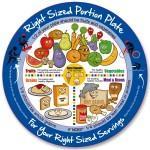Here is a study that gives us all something to think about, especially as we are trying to help our young children develop healthy eating habits.
 MONDAY, April 8 (HealthDay News) — Small children who are given large plates and then allowed to serve themselves take more food and consume more calories, new research finds.
MONDAY, April 8 (HealthDay News) — Small children who are given large plates and then allowed to serve themselves take more food and consume more calories, new research finds.
The study used 41 first-graders in a Philadelphia elementary school to test whether adult research on dishware size and food intake also holds true for children.
“We found that children served themselves about 90 more calories when they used the large plate at lunch [compared to a small plate],” said Katherine DiSantis, assistant professor of community and global public health at Arcadia University in Glenside, Penn.
It turns out, however, that the children had a case of eyes-bigger-than-stomach. “They ate approximately half of every additional calorie they served themselves,” DiSantis said.
The study, funded by the U.S. Department of Agriculture, was published online April 8 in the journal Pediatrics and will be in the May print issue of the journal.
Obesity in children is a growing problem in the United States. About 17 percent of children aged 2 to 19 are obese, according to the U.S. Centers for Disease Control and Prevention.
“In adults, the size of the dinner plate is known to affect how much they put on it and how much they eat,” DiSantis said. Other research has found that kids eat more food when they are served larger portions. But it was not known, DiSantis said, “Whether the use of larger, adult-sized plates would make kids take and eat more food if they served themselves.”
The researchers invited the 41 first graders from two different classrooms at a private elementary school to eat lunch, using a small child’s plate first and then an adult-sized one. The children had their choice of an entree and side dishes (pasta with meat sauce, chicken nuggets, mixed vegetables and applesauce). They all got fixed portions of milk and bread with each meal.
The researchers weighed the portions before and after the children ate and calculated their caloric intake.
“The two factors — plate size and being allowed to take their own food — seemed to work together, DiSantis said. “Overall, the adult-sized dishware by itself did not promote eating more.”
The child’s body-mass index (a measure of body fat based on height and weight) didn’t seem to predict who would take more food, the researchers found.
It was the child’s liking for the food that predicted what they would serve themselves. Those who liked the entree helped themselves to about 104 calories more at the meal.
DiSantis said, “Children look to their environment for some direction when put in the position of making decisions about how much food to serve themselves.”
“In the study, the differences in calories were not large,” she acknowledged. “But if this went on on a daily basis, it could contribute to the child’s overall energy intake and their weight status,” she said. “Using smaller plates might give children guidance on portion sizes, she added.
A nutrition expert who reviewed the study downplayed the role of plate size, while not dismissing it entirely.
“In the end, it’s the portion that’s served rather than the plate size — and whether or not the child likes the food — that influences how much they eat and how much they serve themselves,” said Marjorie Freeman, associate professor of nutrition, food science and packaging at San Jose State University in California. In her own research, she has found that as portion size increases, so does the amount you eat.
Freeman suggested that parents follow the U.S. Department of Agriculture’s recommendations, which suggest filling half the plate with fruits and vegetables.
Parents also can choose plate sizes for serving their children based on what will be on the plate. “For foods you want them to eat a lot of, such as fruits and vegetables, I’d put it on larger plates,” she said.
The fried chicken nuggets, she added, could be served on a small plate.
The study authors noted that the kids in the experiment served themselves more fruit on their large plates, but not more vegetables.
More information
To learn more about how to eat healthy foods, visit ChooseMyPlate.gov.

